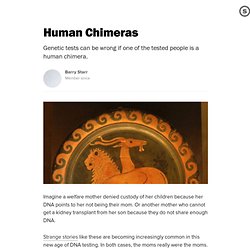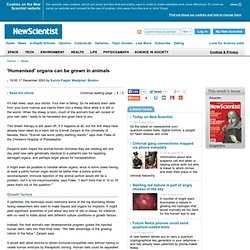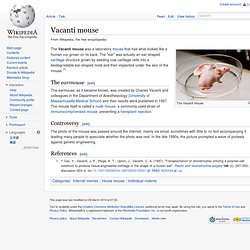

'Splice' Trailer. Human Chimeras: These Fused Fraternal Twins Can Confuse DNA Tests. Imagine a welfare mother denied custody of her children because her DNA points to her not being their mom.

Or another mother who cannot get a kidney transplant from her son because they do not share enough DNA. Strange stories like these are becoming increasingly common in this new age of DNA testing. In both cases, the moms really were the moms. The Mind-Blowing World of Human Chimeras. 'Humanised' organs can be grown in animals. Read full article Continue reading page |1|2 It's bad news, says your doctor.

Your liver is failing. So he extracts stem cells from your bone marrow and injects them into a sheep fetus while it is still in the womb. When the sheep is born, much of the animal's liver will consist of your own cells - ready to be harvested and given back to you. This dream therapy is still years off, if it happens at all, but the first steps have already been taken by a team led by Esmail Zanjani at the University of Nevada, Reno. Zanjani's team hopes the animal-human chimeras they are creating will one day yield new cells genetically identical to a patient's own for repairing damaged organs, and perhaps larger pieces for transplantation. It might even be possible to transfer whole organs, since in some cases having at least a partly human organ would be better than a purely animal xenotransplant.
Growth factors Providing the method really does produce normal human cells, they would not be rejected. Scientists create animals that are part-human. RENO, Nev. — On a farm about six miles outside this gambling town, Jason Chamberlain looks over a flock of about 50 smelly sheep, many of them possessing partially human livers, hearts, brains and other organs.
The University of Nevada-Reno researcher talks matter-of-factly about his plans to euthanize one of the pregnant sheep in a nearby lab. He can’t wait to examine the effects of the human cells he had injected into the fetus’ brain about two months ago. “It’s mice on a large scale,” Chamberlain says with a shrug. As strange as his work may sound, it falls firmly within the new ethics guidelines the influential National Academies issued this past week for stem cell research. In fact, the Academies’ report endorses research that co-mingles human and animal tissue as vital to ensuring that experimental drugs and new tissue replacement therapies are safe for people. Mice With Human Brain Cells Created. December 14, 2005 Researchers in California have created living mice with functioning human stem cells in their brains.

The feat could boost stem cell therapy research on brain diseases like Parkinson's and Alzheimer's—and raises the specter of animal-human hybrids. Vacanti mouse. The Vacanti mouse The Vacanti mouse was a laboratory mouse that had what looked like a human ear grown on its back.

The "ear" was actually an ear-shaped cartilage structure grown by seeding cow cartilage cells into a biodegradable ear-shaped mold and then implanted under the skin of the mouse.[1] The earmouse[edit] The earmouse, as it became known, was created by Charles Vacanti and colleagues in the Department of Anesthesiology (University of Massachusetts Medical School) and their results were published in 1997. The mouse itself is called a nude mouse, a commonly used strain of immunocompromised mouse, preventing a transplant rejection. Controversy[edit] The photo of the mouse was passed around the internet, mainly via email, sometimes with little to no text accompanying it leading many people to speculate whether the photo was real.
References[edit] Chimera (genetics) A chimera (also spelled chimaera) is a single organism composed of genetically distinct cells.

This can result in male and female organs, two different blood types, or subtle variations in form.[1] Animal chimeras are produced by the merger of multiple fertilized eggs. In plant chimeras, however, the distinct types of tissue may originate from the same zygote, and the difference is often due to mutation during ordinary cell division. Normally, chimerism is not visible on casual inspection; however, it has been detected in the course of proving parentage. Another way that chimerism can occur in animals is by organ transplantation, giving one individual tissues that developed from two different genomes.
For example, a bone marrow transplant can change someone's blood type. This condition is either inherited or it is acquired through the infusion of allogeneic hematopoietic cells during transplantation or transfusion. Docs - Online documents, spreadsheets, presentations, surveys, file storage and more.